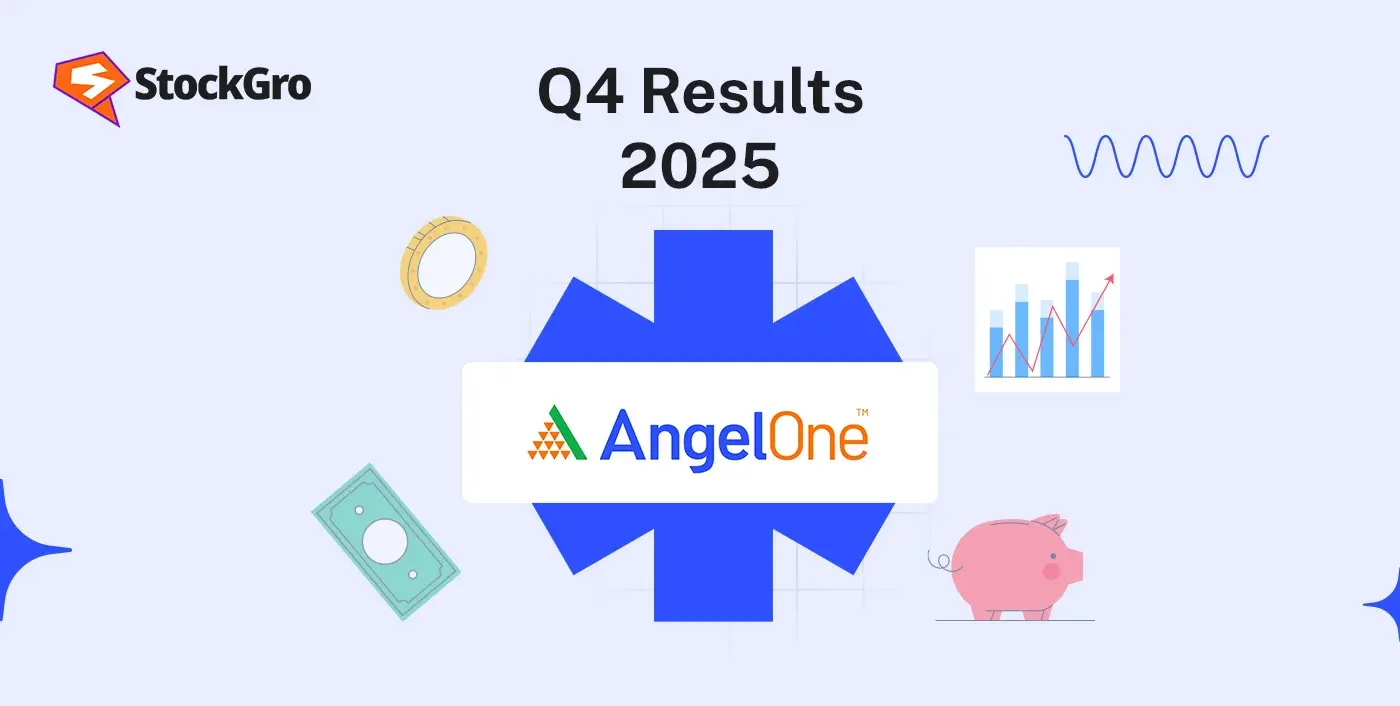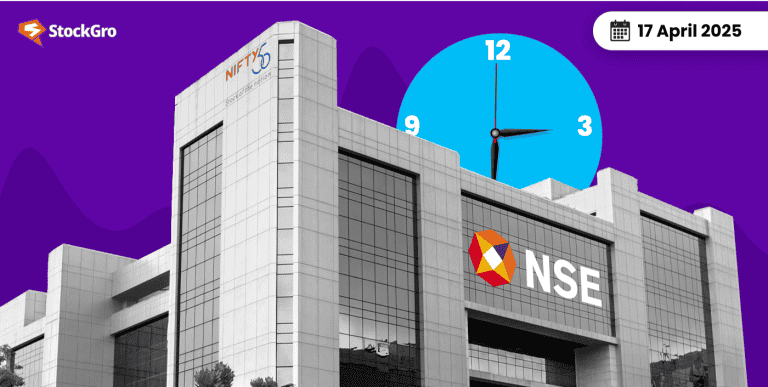
Angel One’s latest quarterly results surprised many investors – and not in a good way. The online brokerage’s stock plunged about 6% in a single day after it announced its Q4 FY2025 earnings. So, what exactly went wrong? Let’s break down the numbers!
About Angel One
Angel One (formerly Angel Broking) is one of India’s largest retail stock brokerage platforms. The company makes most of its money from broking (commissions and fees when clients trade) and related services like margin funding.
It has grown rapidly by offering low-cost trading through its app, attracting a huge client base (over 3 crore clients as of early 2024).
How did Angel One perform in Q4 FY25?
In the January–March 2025 quarter (Q4 of FY 2024-25), Angel One’s performance took a downturn compared to a year ago. Here are the key highlights from the Q4 FY25 financial results:
Revenue: The company’s revenue from operations fell about 22% year-on-year, coming in at ₹1,056 crore for Q4 FY25. This means Angel One earned considerably less this quarter than it did in the same period last year (when revenues were around ₹1,357 crore).
Net Profit (PAT): Profit after tax nearly halved, dropping 48.7% YoY to just ₹174.5 crore. In Q4 of last year, profit was roughly ₹340 crore, so this is a significant slump in earnings. In other words, for every ₹2 of profit Angel One had a year ago, it earned only about ₹1 this quarter.
Operating Profit (EBITDA): The operating profit also took a hit. It came in at about ₹342.8 crore, which is 35% lower than the year-ago quarter. The company’s operating profit margin (how much profit it makes from its revenue after core expenses) shrank to 32.5%, down from about 39% last year. This indicates higher costs or lower fee income (or both) squeezed its profitability.
Broking Revenue: Since Angel One’s main business is broking, this figure is important. In Q4, net broking revenue dropped ~28% year-on-year to ₹490.6 crore (versus ₹685.6 crore in the March 2024 quarter). Less trading activity (especially in derivatives) directly hurt the fees and commissions the company earned.
Client Addition: Angel One is still adding new customers, but at a slower pace. It added about 16 lakh new clients (1.6 million) in Q4 FY25. However, this was 22.4% fewer new clients than it added in the previous quarter, indicating that growth in its user base is cooling off a bit.
Dividend: On a somewhat positive note, Angel One’s board announced a final dividend of ₹26 per share for FY25. This means shareholders will get ₹26 for each share they own, which is the company’s way of sharing some profits (despite the tough quarter) with investors.
Also read: ICICI Prudential Q4 results analysis
To recap these numbers at a glance, here’s a quick summary table of the key Q4 FY25 financial metrics and how they changed:
| Metric | Q4 FY25 Results (Change) |
| Revenue (Operations) | ₹1,056 crore (down 22.2% YoY) |
| Profit After Tax (PAT) | ₹174.5 crore (down 48.7% YoY) |
| Net Broking Revenue | ₹490.6 crore (down 28% YoY) |
| Operating Profit (EBITDA) | ₹342.8 crore (down 35.3% YoY) |
| New Clients Added | 16 lakh (down 22.4% QoQ) |
| Final Dividend | ₹26 per share (for FY25) |
As we can see, the declines in revenue and profit are quite steep. Such a sharp drop in profit (nearly 49% lower than last year) is not something investors take lightly – it was a clear signal that the quarter was much weaker than expected.
Why did Angel One’s profits plunge?
Now, you might be wondering: What caused such a big drop in Angel One’s revenue and profit? Several factors played a role, mostly related to the market conditions and regulatory changes during the quarter:
New F&O Trading Rules: A big chunk of Angel One’s business comes from derivatives trading (F&O – futures and options). Recently, regulators implemented stricter rules for F&O trading (for example, higher margin requirements and other curbs).
These changes put a damper on trading volumes in the F&O segment across the industry. Fewer people trading or lower volumes mean lower brokerage fees for Angel One. In fact, the company itself acknowledged that its Q4 revenue was hit by the new F&O regulations and an overall weaker trading environment.
Market Slowdown: The January–March period saw a relatively lacklustre stock market. There was notable volatility globally (geopolitical tensions, etc.), and Indian markets were not very bullish either. When markets are quiet or falling, casual investors trade less.
For a brokerage like Angel One, that translates to lower business. The company’s brokerage income falling by 28% YoY is evidence of this slower market activity impacting their top line.
Higher Costs (IPL and More): While income dropped, Angel One’s expenses didn’t drop as much. In fact, the firm had elevated costs this quarter, notably some heavy marketing and promotional expenses.
One highlight was IPL sponsorships/ads (IPL is the Indian Premier League cricket tournament), which don’t come cheap. The result? Marketing and other operating costs ate into profits. As one brokerage analysis noted, Angel One’s profit was dented by “an elevated cost structure and IPL spends” during Q4. So, even as revenue fell, costs like advertising, tech investments, and staff still had to be paid, squeezing net earnings.
All these factors combined to create a double whammy: lower revenues and higher relative costs, leading to much lower profits. In short, Angel One faced a tough quarter where the usual tailwinds (active traders, buoyant markets) turned into headwinds.
You may also read: IREDA Q4 results key takeaways
How did the stock react to the results?
The stock market didn’t take this news kindly – hence the 6% drop in Angel One’s share price. On the morning of April 17, 2025, right after the Q4 results were announced, Angel One’s stock tanked over 6% intraday to around ₹2,201 per share. Investors were clearly caught off guard by how weak the earnings were compared to expectations (the profit numbers were below what many analysts had estimated).
By the end of the day, the stock closed roughly 6.5% lower, around ₹2,200, wiping out a chunk of its market value. For context, the stock was about ₹2,352 the day before, so that’s a significant single-day fall. This sharp reaction tells us that the market was disappointed – the results fell short of the growth trajectory that investors were hoping for.
It’s not just a one-day story either. Angel One’s shares have been under pressure for a while:
- Year-to-date (2025): The angel one share price has slid about 25% in 2025 so far, significantly underperforming the broader market (the Nifty50 index was down only ~1.5% in the same period). This means Angel One’s stock was already on a downward trend even before these Q4 numbers came out.
- Off Its Peak: The stock is now nearly 37% below its 52-week high of ₹3,502.6. Some of that decline happened in late 2024 when the overall market and tech stocks were wobbling.
- Past Year: Over the past 12 months, Angel One’s share price is down about 18%. So, shareholders have been seeing their investment value erode over the year, not just in this quarter.
All this paints a picture of a stock that’s been struggling, and the weak Q4 FY25 earnings report was another blow. The company did try to soften the blow by declaring that ₹26 final dividend, which is a decent payout. Sometimes, a dividend can signal that management is optimistic about the business (since they’re willing to return cash to shareholders). But in this case, the earnings miss was the bigger story overshadowing the dividend announcement.
What’s next for Angel One investors?
After a setback like this, the big question is: What’s next? Should investors be worried about the future, or is this a bump in the road for Angel One? Here are a few points to consider going forward:
Management’s Take & Strategy: Angel One’s management acknowledged that FY25 (especially the second half) was challenging due to external headwinds. The good news is they’re not sitting idle. The company has some levers to pull to get back on track.
For instance, they hinted at adjusting their pricing – possibly reworking brokerage plans or offering new pricing strategies – to help revive revenue growth and protect margins. In other words, if new regulations are hurting volumes, they might tweak their business model or fees to attract more customers or trades.
Margin recovery plans: Despite the hit to profits, Angel One is aiming to improve its profitability again. Analysts from Motilal Oswal Financial Services (a brokerage firm that tracks Angel One) noted that with some cost control and pricing changes, Angel One could bring its profit margins back to the 45-50% range in the longer term.
Currently, as we saw, the operating margin is about 32.5%, so they’re talking about a substantial recovery. It won’t happen overnight, but it signals that the current margin squeeze might be temporary if the company executes well.
New Business Avenues: Beyond just stock broking, Angel One has been expanding into other financial services. The company has started new ventures in loan distribution, fixed deposits, wealth management, and even its own asset management (AMC) business. These could become important growth drivers in the coming years.
Industry outlook: The factors that hurt Angel One in Q4 – like the F&O rule changes and a sluggish market – are industry-wide issues. They affect other brokerage firms too. If market activity picks up later in the year (say, due to a bull run or improved investor sentiment), Angel One stands to benefit from that rising tide. Conversely, if trading volumes stay muted, all brokers, including Angel One, might continue to feel the pinch. Investors should keep an eye on overall market volumes and the regulatory environment, since those will influence Angel One’s fortunes.
Analyst Sentiment: Despite the weak quarter, many analysts haven’t written off Angel One. Some analysts still have a ‘buy’ rating on the stock, believing that the company’s long-term story – of growing digitisation of investing in India – is intact.
They argue that short-term hiccups (like rule changes or one bad quarter) don’t derail the fundamental trend of more Indians investing, which benefits platforms like Angel One. That said, analysts will be closely watching the next few quarters. If the company fails to stabilise or improve its numbers, sentiment could change.
You may also read: TCS Q4 results 2025: Key takeaways
Bottom line / Key takeaway:
The 6% drop in Angel One’s share price after Q4 FY25 reflects a reality check – growth has cooled, and profits took a sharp hit due to a tough environment. For current investors, it’s certainly a bit of a bumpy ride. However, Angel One isn’t standing still. The firm is attempting course corrections (like potential pricing tweaks) and is investing in new businesses to diversify its income. The generous ₹26/share dividend also shows they’re still returning value to shareholders even in a slower year.
If you’re an investor or considering Angel One, it’s a time to stay informed and perhaps slightly cautious. Over the longer term, the stock’s fate will hinge on whether Angel One can adapt to the new rules, reignite its earnings growth, and capitalise on its large client base for more than just stock broking.

